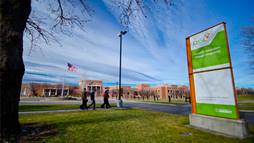In the International Year of Soils, EMSL Researchers Dig Deep
 Photo courtesy of Dave Anderson, EMSL
Photo courtesy of Dave Anderson, EMSL
At the Department of Energy's EMSL, scientists from around the world conduct experimental and theoretical research to understand the environment on a molecular level.
We sweep it and scoop it, dig it and dump it. But do we really know dirt – about dirt?
At the Environmental Molecular Sciences Laboratory (EMSL), a U.S. Department of Energy (DOE) Office of Science User Facility at Pacific Northwest National Laboratory, researchers study the complex properties of soil and its interactions at a molecular level because of soil's importance to our lives – so important that the United Nations has declared 2015 to be the "International Year of Soils" to raise awareness of soil's significance. EMSL provides researchers from across the U.S. and other countries with leadership and access to its expertise, including more than 150 experimental instruments and its supercomputer – Cascade – for typically no cost to scientists from academia, government labs, and industry.
To carry out investigations into the complexities of soil science, research teams and individual investigators from outside institutions working alongside EMSL scientists have been applying EMSL's scientific and computational capabilities and developing new methods of analyzing and characterizing the composition of soils to help better understand them and how they contribute to processes important to DOE.
Most recently, EMSL has coordinated with another DOE Office of Science User Facility, the Joint Genome Institute (JGI), which is managed by the Lawrence Berkeley National Laboratory, to enable scientists to leverage opportunities in genomics research at JGI and molecular characterization at EMSL at the same time. The JGI-EMSL Collaborative Science Initiative (JECSI) is supporting a number of user projects, including two that are led by outside researchers working with EMSL and with JGI scientists and equipment on soil studies.
One group led by Virginia Rich from the University of Arizona monitors carbon cycling at a permafrost site in sub-arctic Sweden. Permafrost acts as a big "freezer," currently storing twice the carbon the atmosphere contains. As this freezer thaws from climate change, its carbon will become available to microbes that convert carbon to simpler compounds; these simpler compounds include the greenhouse gases carbon dioxide, carbon monoxide, and methane that could further drive global warming. Understanding carbon cycling in this frozen environment is critical to determining how thawing will impact climate change.
The roots of a common Mediterranean grass, Avena fatua, are the focus of a second joint JECSI study led by Mary Firestone from the University of California, Berkeley. Firestone's team follows carbon as it moves from the grass roots into soil microbes, then into the surrounding area. A closer look at the root/microbe interaction may explain the decomposing and dispersing mechanisms responsible for spreading carbon in the soil and, in turn, this knowledge will help to better project the soil's response to environmental changes.
 Photo courtesy of EMSL
Photo courtesy of EMSL
EMSL, the Environmental Molecular Sciences Laboratory, is a Department of Energy national scientific user facility located at PNNL.
Among EMSL's regular user projects, one study being led by Johannes Lehmann from Cornell University is examining fires and the resultant char (the blackened remains of trees and shrubs), to address concerns about soil carbon storage. Char is a form of carbon that can be sequestered in soil. Soils contain a surprising amount of char, and the slower it breaks down, the longer carbon stays in soil. Scientists are analyzing the distribution of char carbon at a fine scale to understand the interactions that drive decomposition and retention of char. The answers could then help predict if adding char will change the amount of carbon stored in soil.
Malak Tfaily from EMSL is supporting a PNNL team investigating the effects of environmental changes that have occcurred over a 17-year period. By transplanting soil to new locations, and then comparing changes in the genes of microbes at these different locations, scientists can identify adaptations in the structure and function of microbial communities, along with changes in soil chemistry caused by relocation to hotter, drier or cooler, wetter locations – effectively mimicking climate changes.
These examples illustrate how applying EMSL's unique tools and expertise are providing an in-depth understanding of how soils are changing in response to environmental and climate changes. That, in turn, will better prepare us for the challenges ahead. That's why, at EMSL, it's a joy to dig for answers.
For more information:
Spotlighting humanity's 'silent ally,' UN launches 2015 International Year of Soils
Dr. Jo Handelsman, associate director for science at the White House Office of Science & Technology Policy, authored a blog post titled, "Why Soil Rocks."
Dr. Erika Marin-Spiotta, University of Wisconsin, Madison will speak on August 26, 2015 at Richland, Washington at EMSL Year of Soils Seminar Series
The Office of Science is the single largest supporter of basic research in the physical sciences in the United States and is working to address some of the most pressing challenges of our time. For more information, please visit http://science.energy.gov.
Sandra Allen McLean is a Communications Specialist in the Office of Science, sandra.mclean@science.doe.gov

